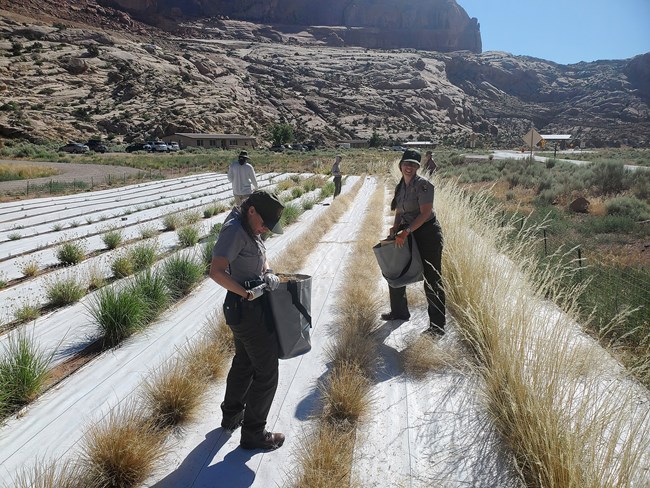Last updated: December 5, 2024
Article
Bipartisan Infrastructure Law and Burned Area Rehabilitation funds support restoration of native plants in southeast Utah

NPS
In fiscal year 2024, NPS used Bipartisan Infrastructure Law (BIL) and Burned Area Rehabilitation (BAR) funding to enhance native seed harvest in Arches National Park (Arches). The seed will be used for restoring public lands in southeast Utah after wildland fire or other disturbances.
In 2022, staff created a fenced and irrigated seed increase field, a field of native plants that will provide seed to be used in restoration efforts, from an area that was disturbed during the construction of a new wastewater leach field for the park’s visitor center. The plants in the field are not harvested themselves but provide seeds that are harvested year after year.
In 2023, six pounds of native seeds were harvested from thirteen species of plants. Species growing in the field include squirreltail grass, needle-and-thread grass, Indian ricegrass, and Hopi blanketflower, all of which are native to Arches and are foundational species in southwestern desert ecosystems. The seed increase field reduces impacts to the park as biologists do not need to collect as much seed from wild plants, many of which have had decreased yields in recent years.
Funded $17,000 from 2024 BIL funds, Arches has grown the program within its current footprint by increasing the number of plants since establishing the field and upgrading the irrigation system. The 2024 BIL funds have supported growth of the park’s Weed Warriors/Seed Stewards volunteer program, provided a refrigerated storage unit to keep harvested seeds preserved for future needs, and provided three pay periods of staff time for a biologist to maintain the field and irrigation system, and to coordinate volunteers and seed harvesting.

The seeds harvested from the seed increase field will be used to restore native ecosystems in southeast Utah and surrounding areas after disturbances such as wildland fire, infrastructure projects, and visitor impacts; for revegetation of invasive species removal areas; or for restoration of lands still recovering from grazing decades ago. Despite the project being in its infancy, the seed increase field has already provided seed to Arches, Canyonlands, and Capitol Reef national parks. The seed is also available for local Bureau of Land Management districts to use when needed. The seeds produced in this field are sought after due to their adaptability to future drier and warmer climates. As a secondary and welcome positive impact, the field’s location adjacent to the visitor center has garnered attention and it has become a tool for educating visitors about restoration and the importance of native plant communities.
